Holidays in Hesse with typical Hessian specialties
What is typical for food in Hesse? The Hesse Tourism Authority invites us on a research trip. We will investigate this question on our vacation in Hesse. On this gourmet trip, typical Hessian specialties are on our menu. Butchers, bakers, cheesemakers and winemakers explain their craft and their products to us. Among them, we discover Hessian specialties such as the Ahle Wurst. Char from northern Hesse. The "fairytale gourmet box" from Bad Emstal. Bratwurst specialties from the meat sommelier. These include organic bread and cheese as well as Riesling. They all have one thing in common. They contain ingredients from the region. Eating in Hesse is slow food from a local farmer. The producer knows exactly where the animals come from and how they are raised. A culinary journey, just the way we love it.
Eating in Hesse is adapting to modern trends such as sustainability and organic products by placing greater emphasis on regional and seasonal ingredients. Many restaurants and producers offer dishes and food from local cultivation, often in organic quality. Examples include organic apple wine, regional sausages without additives or traditional dishes such as green sauce, which uses fresh herbs from local gardens. This combination of tradition and modern nutrition reflects the growing trend towards more environmentally friendly and healthier nutrition.

Do you like to travel by motorhome?
- Do you want to rent a mobile home? Then you can find information here, for example, as well as booking options. Or would you prefer to stay overnight instead in a roof tent on the car? In addition, the overnight stay in camping tents is possible.
- Be sure to check our packing list for campers to see whether you have packed everything for your motorhome tour.
- You want to know where you can stay overnight stay overnight in Germany Can you and are you looking for pitches and campsites? You can find information about this under this link.
- Why is a folding e-bike useful when camping?
A culinary trip through Hessen
Our culinary trip across the country was also exciting. That is Slow Travel at its finest. A holiday in Hessen to savor. A route through beautiful landscapes. On country roads that you (almost) have to yourself. With curves. Along the Rhine. Through half-timbered places. With overnight stays in simple village inns that score points with delicious food in Hesse. And with friendly people. The route takes us from the region of Kassel over the Vogelsberg region into the Rheingau and to the green belt around Frankfurt. Hilly landscapes alternate with cereal cultivation areas. Half-timbered villages await us in the Grimmheimat and around the Vogelsberg. The vineyards in the Rheingau trump up with vineyards in the villages and now and then a Gothic church. In the green belt around Frankfurt, we finally notice the proximity to the Main metropolis.
Typical Hessian specialties
Hessian sausage specialties
- The Ahle Wurscht is a raw sausage that is offered in various forms.
- In other regions of Germany, pork rinds are also known as Presssack, Presswurst or Presskopf. There are various recipes for these. The Hessian Presskopf is typical for Hesse.
- Our favorite is the potato sausage.
Hessen specialties - cheese
- Handkäs is often eaten with wine from the Rheingau.
Specialties from Hessen - drinks
- A Frankfurt specialty gift is the Mispelchen in a glass. This is an apple wine specialty with alcohol.
- What would Hesse be without Äppelwoi? Apple wine is just as much a part of it as a Bembel.
Here you can buy typical Hessian specialties
- Kassel weekly market (Kassel) – Ideal for regional products such as Ahle Wurst.
- Upper Hessian Farmers' Market (Alsfeld) – Farm shops and direct marketers with fresh, regional food.
- Apfelwein Wagner (Frankfurt) – Traditional inn for real Frankfurt apple wine and green sauce.
- Monastery Eberbach (Eltville) – Famous for its Rheingau wines as well as its monastery cuisine.
- farm shops in the Rhön – Sell meat and sausage specialties such as Rhön trout.
Typical Hessian specialties from Northern Hesse
Arctic char and wild herbs in the "Blue Duck" in Espenau
Our vacation in Hesse begins with fish specialties from North Hesse. A meal in Hesse with specialties from the region awaits us in the "Blauen Ente" in Espenau. Northern Hesse is known for the Edersee and the fish that are bred in its area. So what could be more obvious than starting with a fish menu. After a wild herb salad with the last strawberries of the season, we are served a char fillet with mashed potatoes. This is spicy seasoned with horseradish. A combination that we weren't aware of until then. The trout come from the Reinhardswald, where the Dworak family operates a fish farm. In the “Blauen Ente”, care is taken to cook down-to-earth. The ingredients come from the local farmers. Or even from their own herb garden. In the style of rural cuisine, there is a sour cream mousse with rhubarb groats at the end.
The “Blaue Ente” is the à la carte restaurant in the
Waldhotel Schäferberg *
Wilhelmsthaler Str. 14
34314 Espenau near Kassel
The "Ahle Wurscht"
Anyone from Hesse who is asked which Hessian specialties you should definitely try recommends the “Ahle Wurscht” or “Worscht”. We are therefore particularly curious about our visit to the Koch Landfleischerei in Calden. The butcher's shop is now in the sixth generation of the family. Eating in Hessen with tradition, so to speak.
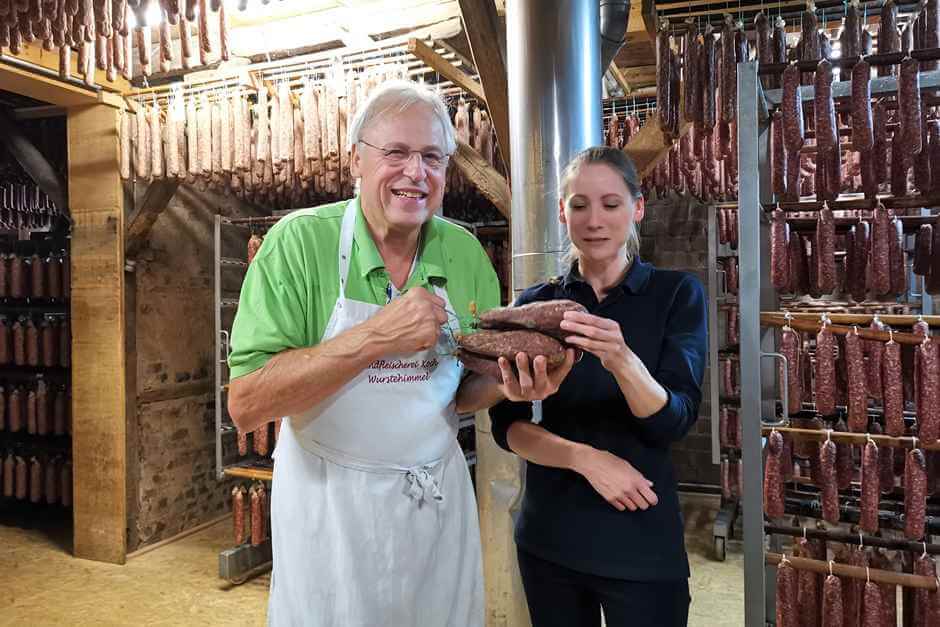
Since January 2018, Katharina Koch has taken over the scepter from her father Thomas Koch. She was not at all destined for this job. Her two brothers, older than her, seemed predestined. Therefore, Katharina first studied political science at the Sorbonne in Paris. She then worked at the United Nations in New York. However, she quickly realized that this life was not the kind she wanted to live. Her two brothers declined when her father offered to succeed him in the butcher shop. So she returned to her parents' business. She is now a master butcher and is in "sausage heaven" among the sausages of the local butchery, as if she had always belonged there.
What is so special about the Ahle Wurst?
In the sausage ripening hall she explains what Ahle Wurst is. It is a raw sausage that uses all kinds of pork from the pig. Even loin and ham are mixed into the Ahle Wurst. This meat comes from farms in the area. The animals are to be slaughtered as stress-free as possible. Excessive adrenaline is harmful to the taste of the sausage. The drive to the slaughterhouse is for many just around a few corners in the village. Then the animals are stunned and don't feel anything of the actual slaughter process. The raw meat is chopped body warm and mixed with spices. The spice blends are prepared by the chefs from fresh ingredients.
Since 2023, the Ahle Wurst has officially become a protected geographical indication! This means that a sausage can only be called "Ahle Wurscht" if it was made in northern Hesse. Manufacturing, processing and aging must all take place in this area. This preserves a regional specialty.
Ahle Wurst is varied
"Garlic definitely belongs in there," Katharina tells us. "Fresh garlic, not powder." The taste of the Ahle Wurst depends on its shape, the duration of ripening and the spices. There is even an Ahle Wurst that tastes different in different parts of its length. The Hercules club has the shape of a pear. It tastes more spicy at the narrow part in the upper part than at the thick end. There it is more delicate and milder. Feldkieker and Stracke are thinner and mature faster. An Ahle Wurst is a raw sausage that - if properly prepared - will last forever. "We would have to invent an expiration date because there is none," laughs her producer.
Landfleischerei Koch
Mittelstr. 6
34379 Calden
Our vacation in Hessen continues to Bad Emstal in the GrimmHeimat. This is what this part of North Hesse is called because the Brothers Grimm collected many of their fairy tales here. In Bad Emstal we meet Lukas Frankfurth from the Parkhotel Emstaler Höhe, a four-star hotel on the spa park (see photos above). He invites us to a picnic in the rose garden. A fantastically beautiful place to get to know your fairy tale Schlemmer Kiste. For this idea he even received the tourism award of the GrimmHeimat NordHessen. Well deserved, because we enjoy it too
The Fairy Tale Schlemmer Box from the Emstaler Hof
But first, let's find the box. "My guests have to do that too when they hike along the Habichtswaldsteig," he explains. “There are no places to stop on this hiking trail. So we came up with the idea of the Schlemmer box. We hide them in a previously agreed place. As soon as our hikers get there, they know where to look for the crate. Then you can enjoy our warm lunch menu in the middle of nature. ”
A Picnic in the Rose Garden
We start our gourmet picnic with a cool “Frog King” cocktail. The gin-based drink tastes refreshing on this hot summer day. Then we unpack our warm dishes from the gourmet box. In it we find a crab bread in a glass as a starter. The main course includes a 7-herb salmon with kumquat risotto and pak choy, based on the Hessian green sauce. The meat course consists of a fillet of organic pork with potato and celery puree. Finally, for dessert there is panna cotta with cherries. Packed in mason jars, the picnic is easy to consume. This is vacation in Hessen for connoisseurs.

You can organize a picnic with the Fairy Tale Schlemmer Box at the
Parkhotel Emstaler Höhe *
Kissinger St. 2
34308 Bad Emstal
The next stop on our vacation in Hesse is Lauterbach in the Vogelsbergkreis. Here we participate in a
Bratwurst Course with the Meat Sommelier
At the Jägerhof Maar village inn in Lauterbach, master butcher and meat sommelier Hans Schmidt awaits us. The robust Hesse is enthusiastic about homemade sausages. He attaches great importance to the quality of the meat and spices that he uses for his products. His chops come from pigs of the Swabian Hallian breed. These are grown in the Vogelsberg region. He stores the meat in his “treasury”.
There, dry aged beef hangs on the hook, waiting for it to reach the right level of maturity. Only then does Hans Schmidt process it further. With steaks or other dishes. He knows exactly when the meat is ready for his typical Hessian specialties. It can happen that he sends a guest away again and puts him off. "Next week it's time. Then the meat is just right for a perfect rump steak. ”His regular guests know this and are happy to wait. Apparently they know that patience pays off.
Four Bratwursts for Dinner
We have an afternoon to learn from him how to make sausages. We meet him in his butcher's shop, which he runs in the Jägerhof. His colleague Ernst is already preparing the meat for our sausages. He cuts kilos of pork into large cubes. In the meantime, Hans Schmidt explains to us what he's up to: “We make four types of bratwurst. We will be grilling these tonight. Thus you prepare your own dinner. "
He shows us how to make honey fennel sausage, Salsiccia, potato bratwurst and merguez. "We make the spice mixes ourselves," he explains, reaching into pots in which he keeps his ingredients. He is not squeamish with the amount. Especially when it comes to merguez, our astonished looks don't bother him. "A merguez has to be spicy," he laughs as the meat in the bowl turns increasingly fiery. Hessian specialties can challenge the taste buds.
My favorite is the potato bratwurst. These we prepare with mashed potatoes and spices. On the grill plate, it develops a fine aroma in combination with potato and endive salad. A real treat. But the honey-fennel bratwurst and salsiccia taste good too. Only when it comes to the merguez I give up. Since I'm not a friend of spicy food, I prefer to take another potato bratwurst instead.
Barbecue Evening under Chestnut Trees
After the bratwurst course we earned a beer. We treat ourselves to one in the garden of the Eulenfang. This is what Hans Schmidt calls his event barn. This once belonged to the estate of the Riedesel barons of Eisenbach. The estate no longer exists today. It burned down at the end of the 19th century. Schmidt converted the former stables with its cross vault into a hall that he uses for events.
However, the summer weather lures us outdoors. Here we enjoy our grilled sausages in the shade of the chestnut trees.
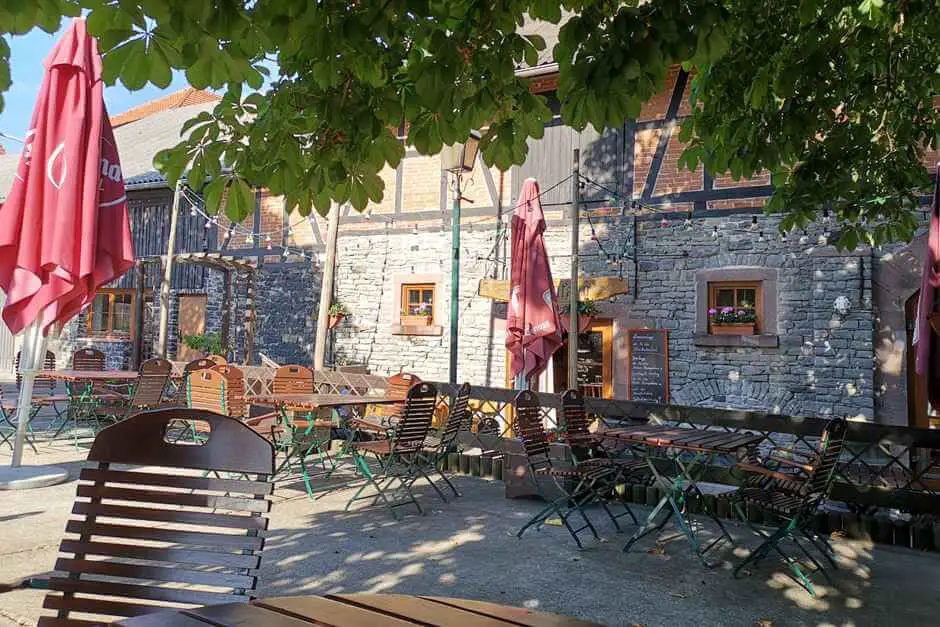
You can join a bratwurst course with Hans Schmidt here:
Jägerhof Maar in Lauterbach
Hauptstraße 9
36341 Lauterbach
After the church bells wake us the next morning at six o'clock, we have time to enjoy breakfast in the Jägerhof Maar before our culinary country tour continues to Schotten. There we visit the
The Vulkanbäcker Haas with his Hessian specialties
We rarely meet someone who is so passionate about his craft as Joachim Haas. We have an appointment with him in his bakery, which already smells seductive. We smell bread. And fresh yeast dough. Or cheesecake. Definitely freshly baked and typical Hessian specialties.
Hessian Specialties from the Oven
First of all: Joachim Haas does not show us typical Hessian specialties from the bakery. Instead, he raves about the grain that grows in certified quality and 100% organic in the fields of the Vogelsberg region. He is particularly proud of that. After all, he had already converted his business to organic baking when organic grain and tested quality were still in their infancy. “Nobody took us seriously at the time,” he laughs. “It looks completely different now. It is important to us that our bread contains organic grain. Because high-quality ingredients ensure good and healthy bread. "
Breads made from Organic Grain for Hessian Specialties
Then he shows us breads that are baked with white wheat flour, with dinkel flour and with rye flour. "What ingredients do you need to bake bread", he asks us, and answers his question himself. "Flour, salt and liquid." What exactly you use for it depends on the quality of the product. The more wholegrain is in the flour, the healthier the bread. You can even see that from the weight. His smallest bread is also his heaviest. "We use the highest quality flour for this," he explains. His customers prefer his beer bread. He bakes this with rye flour. Each loaf also contains a whole bottle of dark beer.
Typical Hessian Specialties - Cakes like my Mother's
He bakes his cakes, brioche, croissants and wholegrain biscuits according to the same criteria. We see some sheets in the bakery as proof. Above all, we smell them. It smells like my mother's bakery. Then he opens his cold rooms, where prepared biscuits are waiting to be baked in the oven. I would like to spend a whole day here - and just try and taste.
Incidentally, Joachim Haas also offers tours through his bakery and baking courses for beer bread. A good stop on a pleasure trip in Hessen.
Get further information at the
Vulkanbäcker Haas
At the Old Field 48
63679 Scots
Our culinary outing continues to neighboring Hungen. There we learn how to make cheese in the Käsescheune Hungen.
Cheese from Hungen - typical Hessian Specialties
Arend-Christopher Buse is the new head cheese maker in the Käsescheune Hungen. He learned his trade in Lower Saxony, where cows and sheep graze on the lush meadows. He leads us through the cheese dairy in the center of Hungen. There is a modern restaurant in the entrance area. Behind it we go up the stairs into the adventure space Sheep and Nature. This is dedicated to the most important milk supplier to the cheese factory. The cheese barn owes its existence to the sheep, because Hungen also describes itself as a shepherd town. Sheep farming has long played a role in the area. Hiking trails "in Schäfer's footsteps" show you more of it, if you plan a longer stay in Hungen.
Sheep and Cheese - Hessian Specialties
We first explore the exhibition about sheep and their importance in the region. It lovingly describes what supports the Vogelsberg to successfully breed sheep. It is the herbs that grow here. They ensure that the sheep's milk gets its taste. This is important for the production of cheese. Arend-Christopher Buse does the rest. He likes to try new things. He is currently testing a cheese to which he is adding carrot juice. "It already has the orange color," he laughs. "Now we only need patience." It takes time for a cheese like this to be ready for consumption. Depending on the type of cheese, this can take up to several months. If his attempt works, Hessian specialties are enriched by another product.
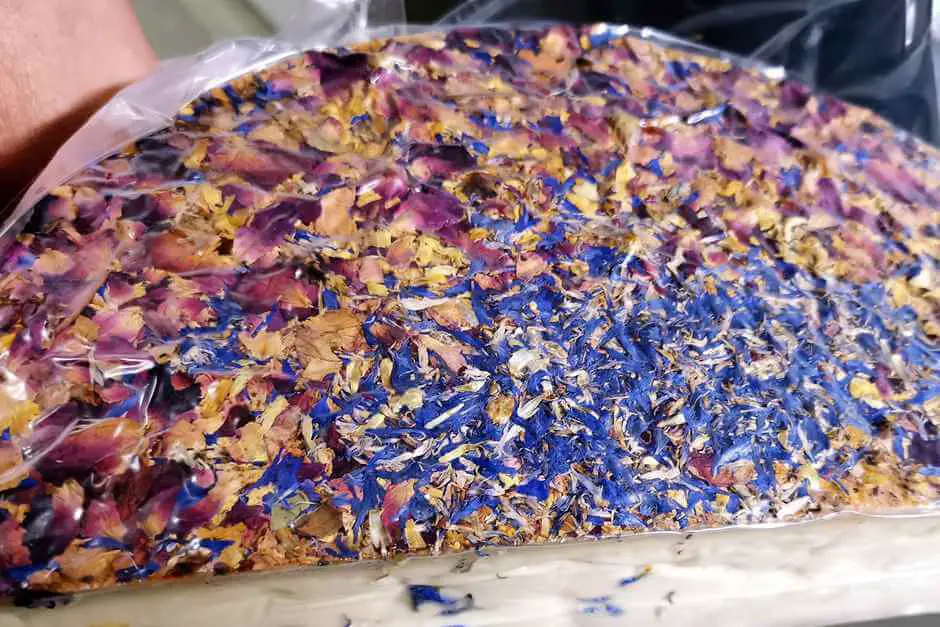
Where Cheese Matures and Gets its Final Appearance
In the basement of the cheese dairy we can take a look at the ripening plant. Even before we enter the "holy halls", a strong smell flows towards us. “You have to get used to that at the beginning,” laughs Arne-Christopher. "But at some point you can't smell it anymore." At the moment, I can't imagine that.
The shelves are full of round cheeses. There is soft cheese, cream cheese and semi-hard cheese. I like the cheese wheels best, which are refined with special ingredients. There is the Licher beer cheese, the Hungener Äppelwoikäse or the Cistercian. This is washed regularly with Riesling. Of course, typical Hessian specialties are also produced, such as the Hungener Spundekäs, with red paprika powder for its taste and appearance.
If you want to inform yourself about cheese from Hungen, you can join one of the guided tours that are offered regularly. In cheese courses, you can also make your own cheese. More information can be found here:
Hungener Käsescheune
Brauhofstr. 3-7
35410 Hungen
We leave the Vogelsberg region and continue to the Rheingau west of Wiesbaden. In the afternoon we reach the Hotel Weinhaus Sinz (Herrnbergstr. 17-19, 65201 Wiesbaden-Frauenstein), where we spend the night. We are staying in one of the country houses that also belong to the Sinz wine house. Our room is modern and tastefully furnished. The terrace is also pleasant, where we enjoy a late lunch. Here we try Spundekäs and Handkäs mit Musik for the first time. Both dishes that are often served with wine in Hesse. We don't want to eat too much, though, because a highlight of our culinary country tour through Hesse awaits us in the evening.
The Rhine in Flames near Aßmannshausen
We drive past Rüdesheim to Aßmannshausen. You can also easily do the route via the Rheinsteig hike. We meet other connoisseurs in front of the Alte Bauern Schänke in Aßmannshausen. With them we hike into the steep vineyard behind the town. There we experience one picnic in the vineyard that the herbalists from Aßmannshausen organize in the vineyard above the town. This Wine event takes place when the “Rhine in Flames” is celebrated between Bingen and Rüdesheim. This is an event organized every summer in several locations along the Rhine. Then ships and boats decorate themselves with lights. As soon as the sun goes down they begin their parade on the Rhine. From the north and south they slowly travel along the Rhine until they meet in Rüdesheim. Always accompanied by fireworks that accompany their parade of ships at several points along the shore. You can hardly experience the Rhine more spectacularly.
At the Picnic in the Vineyard there are Hessian Specialties from the Herbalists
While we wait for the sunset, we enjoy our picnic in the vineyard to the fullest. The appetizers are all served in a basket. Inside are five mason jars with starters. How does asparagus mousse with truffle from smoked trout, buffalo mozzarella with tomato fillets in daisy pesto, Vitello Goethe with green sauce, boiled beef from the "Weiderind" with radish julienne and king prawns with pan vegetables and glass noodles sound for you? Tasty, right?
We then get the main course from the barbecue buffet. The choice is difficult. There are flamed salmon from the vine wood fire, beef ham from the smoker, Black Angus burger from the Feuerring with bacon jam, steaks and sausages and chicken-saté with homemade kimchi. There is a suitable wine from the Rheingau for every course. The herbalists proffer five wines that perfectly accompany the dishes. With the exception of one wine, all come from the Konrad Berg & Sohn winery. We start with a dry Silvaner from 2018 (Lorcher Krone). This is followed by a fine dry Riesling Spätlese (2018 Lorcher Bodenthal). The dry Pinot Noir Bland de Noir (Assmannshäuser Hinterkirch from 2018) is the only one that comes from the Klaus König winery. A dry Pinot Noir from Assmannshäuser Höllenberg comes from the vineyard where our picnic takes place.
For dessert, there is a yoghurt-lime mousse with red fruits and a delicious, homemade popsicle. We conclude the meal just in time with a glass of fruity Rüdesheimer Berg Schlossberg Riesling Auslese from 2016, before the sun sets. Immediately thereafter, the first ships start floating around the curve in the Rhine.
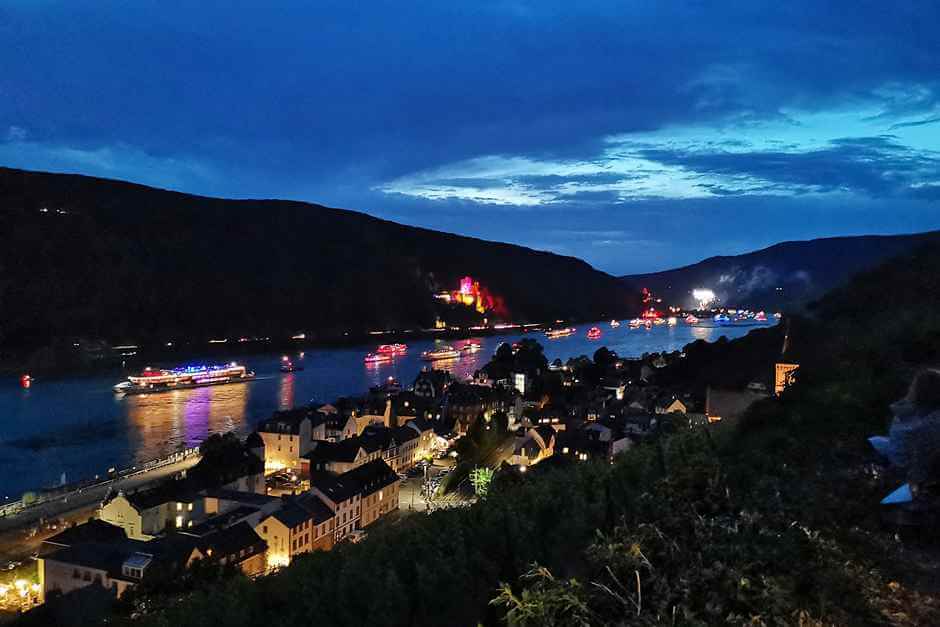
The crowning glory of this evening is the parade of illuminated ships and boats sailing along the Rhine below us. From our viewing terrace in the vineyard, we can see three fireworks. One illuminates the vineyard of Aßmannshausen for several minutes. A terrific spectacle!
A Tip: Reserve your Seat at the Picnic and your Accommodation early
If you want to be part of the picnic in the vineyard by the Rhine in flames next year, you should reserve early. When we were there, the event was sold out at the beginning of the year.
After a late breakfast we set off for the last leg of our culinary tour through Hesse. First we head back to the Rhine in
Weingut Hamm in Oestrich-Winkel serves typical Hessian Specialties
The young organic winemaker Aurelia Hamm and her mother are waiting for us in their patrician house in the middle of town. Opposite and also in the village is one of their vineyards. This extends down to the Rhine. Only one street separates it from the river. It is one of the wine-growing areas of the Hamm family. Overall, their grapevines cover an area of 7 hectares. They grow Riesling on 90% of them. The remaining 10% is reserved for the cultivation of Pinot Noir. The vineyard family has been cultivating these grape varieties for more than 25 years according to ecological principles. Since it rains for the first time on our trip, they invite us to taste our way through the Riesling varieties from the Hamm's vineyards.
Hessian Specialties from the Winegrower of the Rheingau
Aurelia's mother serves us snacks from her kitchen. "I make sure that the ingredients for this come from the region," she tells us. You can taste it too. She plants exotic ingredients in her own garden. In the courtyard, a kiwi provides shade over the tables. The fruits are not yet ripe, but they are hanging close together. "We can harvest the fig right now. You definitely have to try my figs with cheese. ”More appetizers provide a good basis for our wine tasting in the morning. Riesling olives. Prunes wrapped in bacon. Spundekäs. And the absolute highlight: a Swiss chard. With such delicacies and good wines, it is difficult for us to leave the wine tasting. But we also want to see the wine cellar.
The Wine Cellar - the Treasury in the Hamm Winery
The basement is in an annex at the back of the courtyard. In the vaulted cellar you can see that the property is over 500 years old. It is owned by the Hamm family in the third generation, and the wines of the winegrower family are stored under the pointed arches. In one corner, we find Aurelia Hamm's wines. In the other there are the wines that her brother creates. "He's still studying," she explains. "But he is about to graduate. Then we work together in the family winery. "

She points to the basement walls and says: “It is important to build up our basement. The walls are made of sandstone, which creates a connection between the outside world and what is happening here in the basement. The cellar flora on the walls are mushrooms. These are indicators of the atmosphere in the basement. Their smell shows whether the temperature and the humidity in our basement are right. ”
Family tradition is very important at Hamm. There's a lot to tell about that. In 1911, Heinrich Hamm taught Japanese winegrowers how to produce good wine. Three years later, he was allowed to present the first bottle of Japanese wine to the tenno. To this day, people in Japan still remember these beginnings of viticulture. But the younger generations are also proud of their products. Every year the family places one or two bottles of each Riesling variety in their treasury. This is a cellar that lies under the vaulted cellar. Wines from several decades are stacked on the shelves. “We only drink them on special occasions,” Aurelia tells us.
Gutsausschank for Hessian Specialties
If you want to visit the Hamm winery yourself, you can do so when the estate bar is open. “We serve wine lovers between Easter and October, November. At the end of the season there is a goose meal before we close for the winter months. ”You can experience the winery in the courtyard when the weather is nice. It also has two cozy dining rooms where events, wine tastings or gastronomic events take place. Reserve your wine tasting or visit to the Hamm winery here:
Winery and Gutsausschank Hamm
Hauptstraße 60
65375 Oestrich angle
The last stop on our culinary journey through Hesse is the Garni Hotel Kreilings Höfchen in Bad Vilbel. Our goal is the guest garden.
Hessian Specialties according to Homemade Style
As if in a cottage garden, we finally sit in the summer garden of the Kreilings Höfchen under old trees and between roses and lilies. You can order drinks and food at a bar. The menu is definitely hearty. Here you will find Hessian home-made dishes. At the end of our culinary country trip through Hesse, we ordered Hessian tapas. Hessian specialties from home-made cuisine, so to speak.
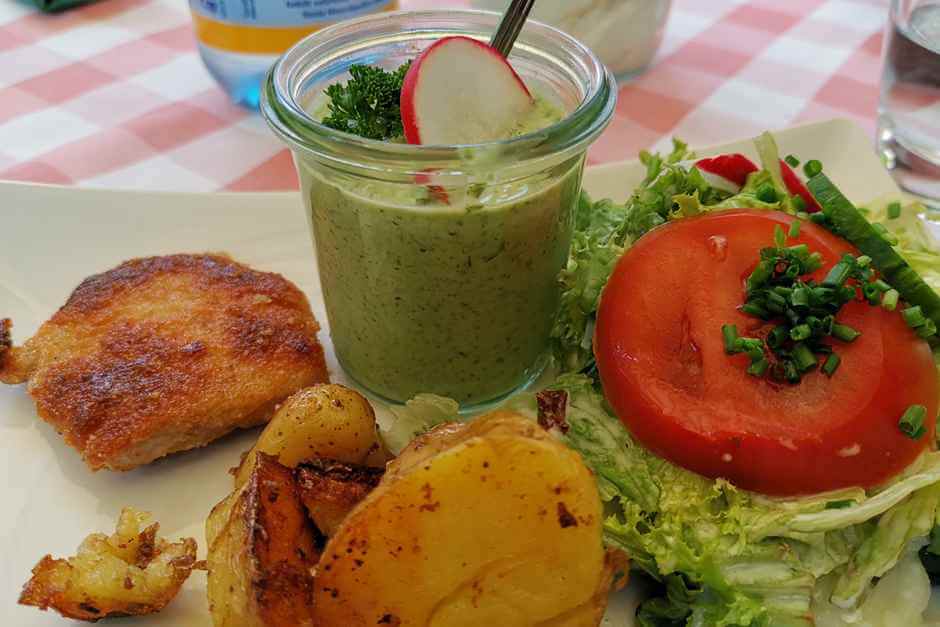
One of them is the Frankfurt Green Sauce. We already had that a few years ago Green sauce in Kassel met in northern Hesse. However, back then it looked different than the one we are served here. We learn that there are indeed differences in the recipes. While the recipe for the original Frankfurt Green Sauce is protected, things are different for the North Hessian sauce. The ingredients for the Frankfurt version must definitely come from the region and be grown according to certain specifications. The Frankfurter sauce is grass green. To do this, you puree the herbs very finely. With Kassel sauce, on the other hand, you cut the herbs into small pieces and don't puree them. In addition, neither chervil, cress nor lovage is used there.
Do you also know the Sachsenhausen snow flurry? Like many other Hessian specialties, this goes perfectly with wines as well as Äppelwoi (apple wine) from Hesse. This is a dish made from Camembert and cream cheese. Add onions, peppers and caraway seeds and the spread is ready. We'll definitely have that at home soon.
Kreiling's Höfchen
Ritterstr. 3
61118 Bad Vilbel
The summer garden is open in good weather: Mon-Fri five - ten pm, Sun. from noon.
Conclusion - where can you Discover Typical Hessian Specialties
We spent three days on our culinary country trip through Hesse. We discovered all kinds of food in Hesse. Fish, cheese, sausage and meat specialties from northern Hesse and the Vogelsberg region. Delicious Riesling wines and elegant antipasti from the Rheingau. Homemade dishes from the green belt FrankfurtIt was an exciting and relaxing journey through Hessian landscapes, which we had not previously considered as a holiday destination. We enjoyed the fact that Hessian cuisine is also worth a look behind the scenes. Hesse is definitely a federal state that offers more than Frankfurt and big business. By the way: there are also good hiking opportunities in the region. So pack your large backpack and your walking boots and explore the region at your leisure. It's certainly not the last time we've been out and about in the diverse regions of Hesse. There is much more to discover.
Another tip: Culinary travel in Europe
Questions and Answers about Eating in Hesse
Which Hessian specialty is suitable for vegetarians?
A classic is the Green Sauce. It consists of fresh herbs such as parsley, chives and borage, served with yoghurt or sour cream. It is often served with boiled eggs and potatoes - perfect for vegetarians!
Where can I find cooking classes for these dishes?
In Frankfurt, some cooking schools offer courses for Hessian specialties, such as the Frankfurt Cooking SchoolThere you will learn how to prepare traditional dishes such as green sauce or hand cheese.
Are there vegan alternatives for Hessian specialties?
Yes! Many traditional recipes can be made vegan. For example, you can make green sauce with vegan yoghurt. Handkäse without music is sometimes offered in vegan versions.
Which markets offer regional Hessian specialties?
The weekly market in Kassel or the Frankfurt Kleinmarkthalle are ideal places to find regional delicacies such as Ahle Wurst, Handkäs or fresh apple wine.
How do Hessian specialties adapt to modern nutritional trends?
Many restaurants and producers rely on regional, seasonal and sustainable products. You can now find organic versions of classics such as apple wine or sausage, and there are also more and more vegetarian and vegan options in Hessian cuisine.
Travel Tips for Hesse
- Frankfurt sights
- Where to eat in Kassel?
- Three UNESCO World Heritage Sites in Kassel
- Baroque water games in Kassel
- Kellerwald Edersee Nature Park - UNESCO World Heritage Site and fairytale home
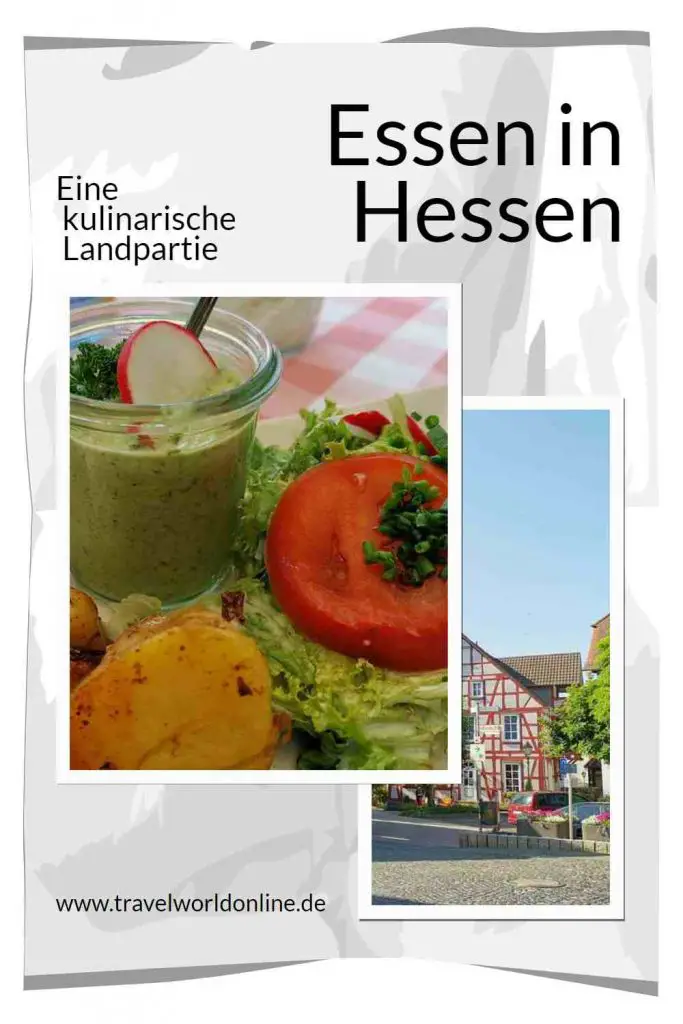
Do you know this?
- the Old town of Stein am Rhein?
- Most beautiful cities on the Rhine
- 5 wine locations for a wine weekend on the Main
- Farm shops with a café near Munich
- Water features in Kassel
- Excursion destinations Hessen
- Frankfurt restaurants in the city center
- Eating out in Quebec, Canada
- New York food
- Ideas for a perfect picnic
- Gas grill recipes
- Buy gas grill online
- Gas grill accessories - why is it worth it?
- Grill Spare Ribs with a Rib Marinade
- Dutch oven sizes
- You can also find Dutch oven accessories
- Luxembourg Specialties
- Mushroom ravioli with garlic butter sauce
- Light hiking shoes for wide feet
- Picnic – what should you bring? You can order it here.
Essen in Hessen: Research on site with the kind support of Hesse Tourism. We would like to thank you very much for this. Our opinions remain our own.
Text Essen in Hesse: © Monika Fuchs and TravelWorldOnline
Photos Essen in Hesse: © Copyright Monika Fuchs and TravelWorldOnline
Video Eating in Hesse: © Copyright Petar Fuchs and TravelWorldOnline
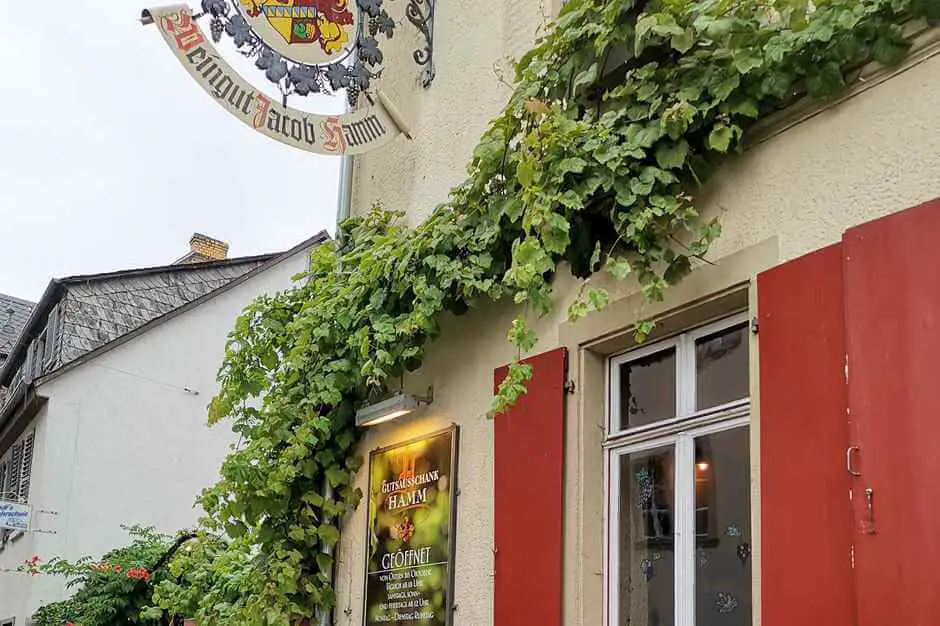
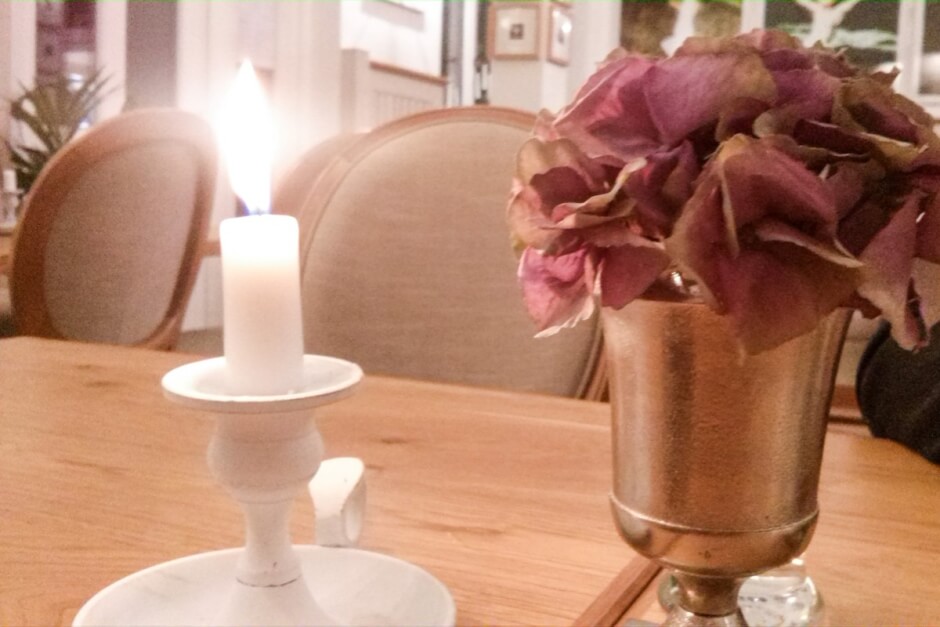

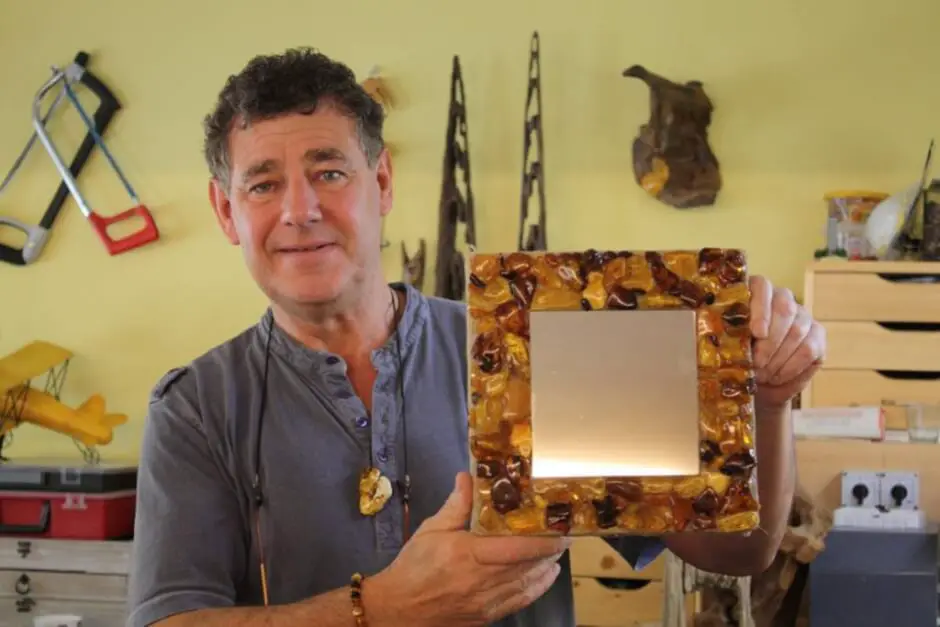
What a fantastic write up, Monika! Sachsenhausen snow flurries!
Hi Azlin,
I am sure, you would love this trip. There is so much to discover and learn. The foods were great and surprised. So it was a great trip, because it took us to different areas of Hesse and showed us the diverse landscapes of this region.
Since you get really appetite, if you read this and watch the videos.
Thank you very much for the nice comment. On the spot this works much better :-).